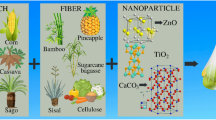Abstract
This work is focused on the hydrolysis of cotton fibers from waste textiles to obtain micro and nanofibers to be used as reinforcements in polymer composites. To promote their compatibility with polymeric matrix, hydrolyzed cotton fibers were surface modified with various silane compounds. Thus, these fibers were mixed with commercial poly(lactic acid) (PLA) at 5% w/w loading by melt compounding. Acid treatments caused a decrease of the crystallinity index whereas the thermal stability was significantly improved, especially for cellulose fibers hydrolyzed in two steps. Morphological analysis revealed a reduction of the fibers diameter and a decrease of their length as a consequence of the hydrolysis. NMR analysis confirmed the silanization of the fibers by reaction with the silane agent. Tensile tests revealed that silanization treatments were able to increase the composite Young’s modulus and the stress at break with respect to the neat matrix, indicating that silanization improved the polymer/fiber compatibility interfacial adhesion. The overall results demonstrated that applying suitable surface modification strategies, waste cotton textiles can be effectively recycled as fillers in polymer based composites.










Similar content being viewed by others
References
Iranpour R et al (1999) Environmental engineering: energy value of replacing waste disposal with resource recovery. Science 285(5428):706–711
Wang Y (2010) Fiber and textile waste utilization. Waste Biomass Valoriz 1(1):135–143
Chen H-L et al (2006) Environmental analysis of textile products. Cloth Tex Res J 24(3):248–261
Avella M et al (2009) Recycled multilayer cartons as cellulose source in HDPE-based composites: Compatibilization and structure-properties relationships. J Appl Polym Sci 114(5):2978–2985
Di Lorenzo ML et al (2012) Isothermal and nonisothermal crystallization of HDPE composites containing multilayer carton scraps as filler. J Appl Polym Sci 125(5):3880–3887
McCrum NG, Buckley CP, Bucknall CB (1997) Principles of polymer engineering, 2nd edn. Oxford University Press, Oxford
Wang Y et al (2003) Recycling of carpet and textile fibers. In: Andrady AL (ed) Plastics and the environment. Wiley, New York, pp 697–725
Avella M et al (2008) Poly(lactic acid)-based biocomposites reinforced with kenaf fibers. J Appl Polym Sci 108(6):3542–3551
Monteiro SN et al (2009) Natural-Fiber polymer-matrix composites: cheaper, tougher, and environmentally friendly. JOM 61(1):17–22
Abdul HPSK et al (2012) Green composites from sustainable cellulose nanofibrils: a review. Carbohydr Polym 87(2):963–979
Avella M et al (2011) Biodegradable PVOH-based foams for packaging applications. J Cell Plast 47(3):271–282
Avella M et al (2012) Polyvinyl alcohol biodegradable foams containing cellulose fibers. J Cell Plast 48(5):459–470
Jonoobi M et at (2010) Mechanical properties of cellulose nanofiber (CNF) reinforced polylactic acid (PLA) prepared by twin screw extrusion. Compos Sci Technol 70(12):1742–1747
Helbert W et al (1996) Thermoplastic nanocomposites filled with wheat straw cellulose whiskers. Polym Compos 17(1): 604–611
Gousse C et al (2004) Surface silylation of cellulose microfibrils: preparation and rheological properties. Polymer 45(5):1569–1575
Abdelmouleh M et al (2005) Modification of cellulose fibers with functionalized silanes: Effect of the fiber treatment on the mechanical performances of cellulose–thermoset composites. J Appl Polym Sci 98(3):974–984
Marques MFV, Oliveira PF (2015) Chemical treatment of natural malva fibers and preparation of green composites with poly(3-hydroxybutyrate). Chem Chem Technol 9(1):211–222
Roman M, Winter WT (2004) Effect of sulfate groups from sulfuric acid hydrolysis on the thermal degradation behavior of bacterial cellulose. Biomacromolecules 5(5):1671–1677
Mamleev V et al (2007) Kinetic analysis of the thermal decomposition of cellulose: the main step of mass loss. J Anal Appl Pyrol 80(1):151–165
Łojewska J et al (2005) Cellulose oxidative and hydrolytic degradation: in situ FTIR approach. Polym Degrad Stab 88(3):512–520
Xiao B et al (2001) Chemical, structural, and thermal characterizations of alkali-soluble lignins and hemicelluloses, and cellulose from maize stems, rye straw, and rice straw. Polym Degrad Stab 74(2):307–319
Yang H et al (2007) Characteristics of hemicellulose, cellulose and lignin pyrolysis. Fuel 86(12–13):1781–1788
Fahma F et al (2011) Effect of pre-acid-hydrolysis treatment on morphology and properties of cellulose nanowhiskers from coconut husk. Cellulose 18(2):443–450
Baheti V et al (2014) Influence of noncellulosic contents on nano scale refinement of waste jute fibers for reinforcement in polylactic acid films. Fibers Polym 15(7):1500–1506
Piekarska K et al (2014) Polylactide composites with waste cotton fibers: thermal and mechanical properties. Polym Compos 35(4):747–751
Acknowledgements
The authors are grateful to CAPES (PNPD Program) for financial support, and Project FP7-People-2011- IRSES-295262 (VAIKUTUS Project) for L. C. Ferreira and Rafael S. Araújo Post-Docs fellowship.
Author information
Authors and Affiliations
Corresponding author
Ethics declarations
Conflict of interest
We wish to confirm that there are no known conflicts of interest associated with this publication and there has been no significant financial support for this work that could have influenced its outcome.
Rights and permissions
About this article
Cite this article
Araújo, R.S., Ferreira, L.C., Rezende, C.C. et al. Poly(lactic acid)/Cellulose Composites Obtained from Modified Cotton Fibers by Successive Acid Hydrolysis. J Polym Environ 26, 3149–3158 (2018). https://doi.org/10.1007/s10924-018-1198-3
Published:
Issue Date:
DOI: https://doi.org/10.1007/s10924-018-1198-3




